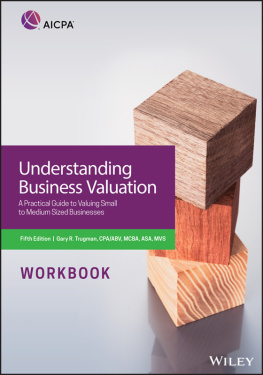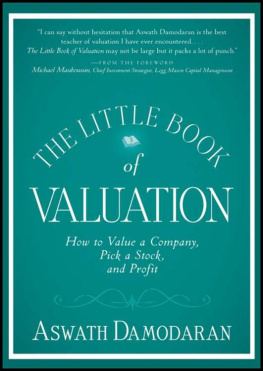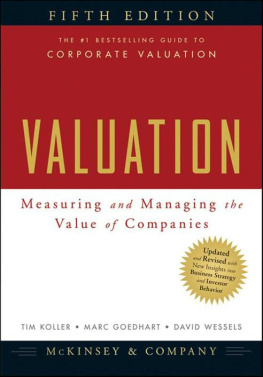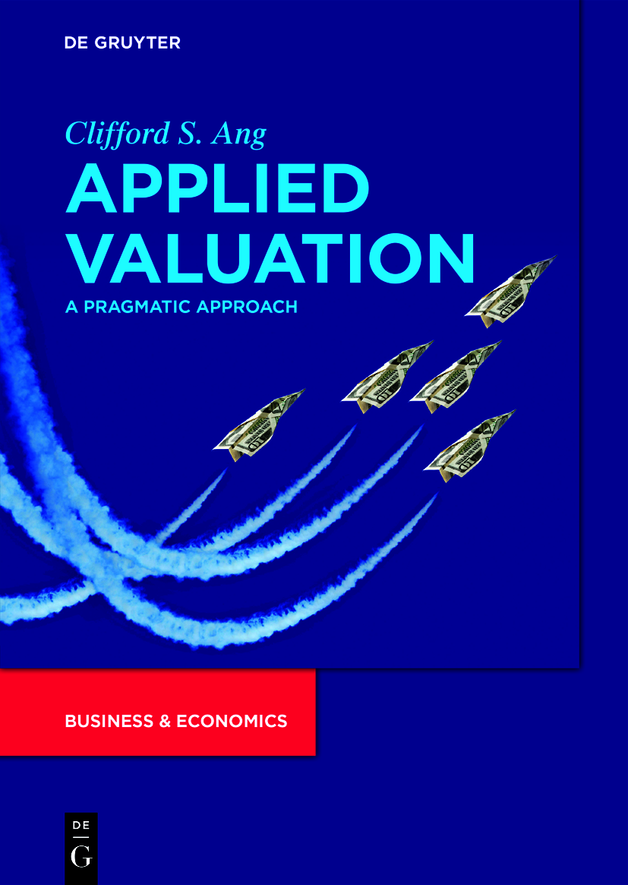ISBN 9783110771749
e-ISBN (PDF) 9783110771787
e-ISBN (EPUB) 9783110771831
Bibliographic information published by the Deutsche Nationalbibliothek
The Deutsche Nationalbibliothek lists this publication in the Deutsche Nationalbibliografie; detailed bibliographic data are available on the Internet at http://dnb.dnb.de.
2023 Walter de Gruyter GmbH, Berlin/Boston
Clifford S. Ang
Applied Valuation
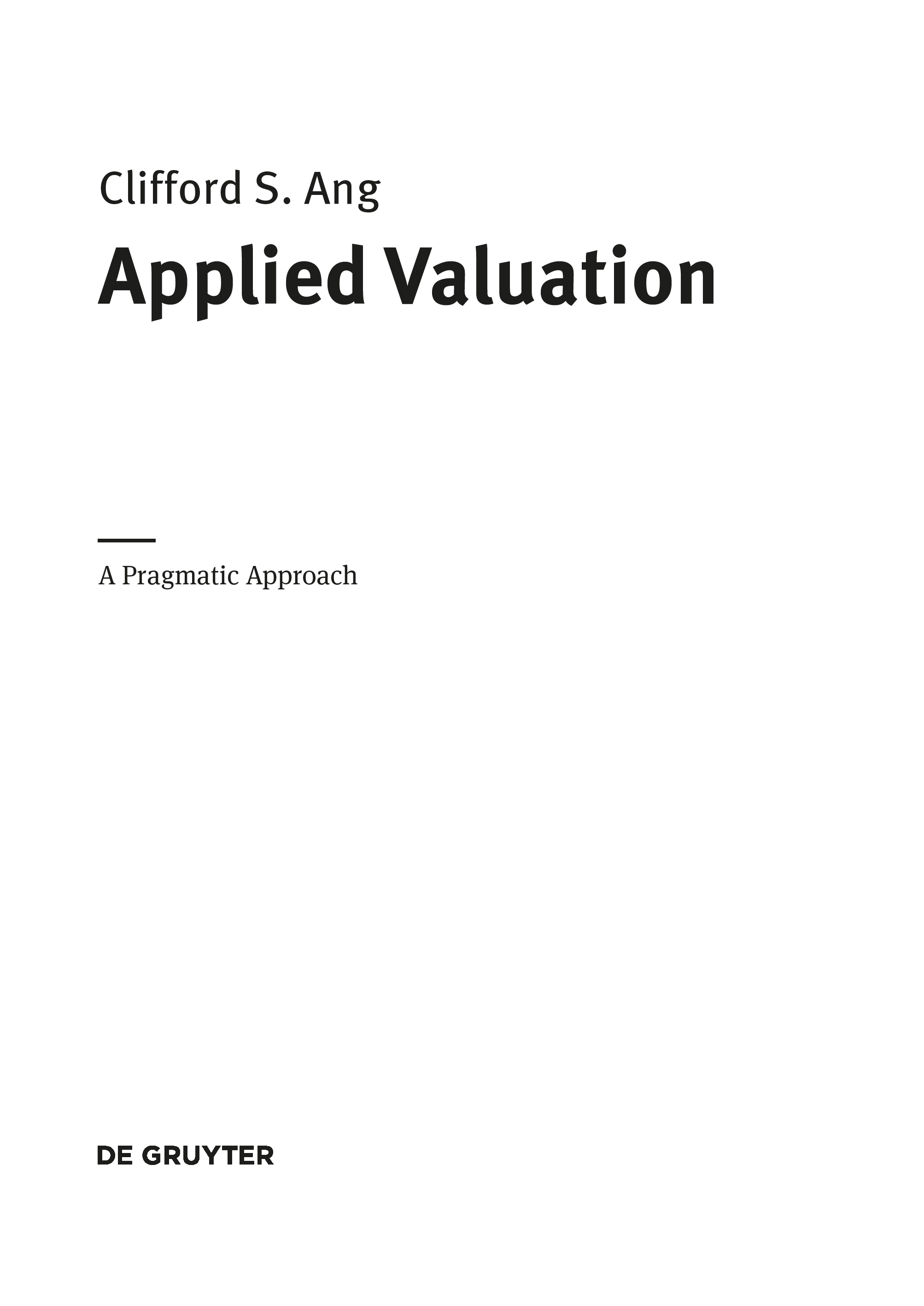
This book is sold with the understanding that neither the publisher nor the author is engaged in rendering legal, accounting, investment, or other professional services or advice by publishing this book. The models and techniques presented in this book are for information purposes only. Each individuals situation is unique and the reader should consult a professional to ensure that any situation has been evaluated carefully and appropriately. The publisher and author make no warranty, expressed or implied, from the use or application of any of the contents of this book. This book also relies on third-party software, data, and packages and neither the author nor the publisher warrant the accessibility, reliability, and accuracy of such third-party data and packages.
Any opinions contained herein are solely those of the author and are not the opinions of Compass Lexecon or its other employees.
ISBN 978-3-11-077174-9
e-ISBN (PDF) 978-3-11-077178-7
e-ISBN (EPUB) 978-3-11-077183-1
Library of Congress Control Number: 2022949263
Bibliographic information published by the Deutsche Nationalbibliothek
The Deutsche Nationalbibliothek lists this publication in the Deutsche Nationalbibliografie; detailed bibliographic data are available on the Internet at http://dnb.dnb.de.
2023 Walter de Gruyter GmbH, Berlin/Boston
Cover image: LockieCurrie / E+ / Getty Images
Printing and binding: CPI books GmbH, Leck
www.degruyter.com

To my wife and kids, whose value cannot be measured.
Preface
Valuation is part art and part science. There is no single way to value a stock. My valuation could be different from your valuation. These differences in valuation are what generates trading in financial markets. If we all had the same valuation for the same stock, then there would be limited benefits to trading.
While there is no single correct way to value a stock, there are definitely incorrect ways of doing so. In this book, my goal is to discuss the various methods that are used to value a companys equity through the lens of an outside investor. This means that the valuation is not done through the eyes of a company insider or a consultant that has access to private information about the company. Such private information should not be reflected in the companys traded stock price.
For most outside investors, we only have publicly available information and, while some companies provide more information than others, the information available to us is likely much less granular for many of the inputs that we would need to value a company. For example, we wont know what machines a company has, how much longer is their useful life, the projected demand for these machines, and other pertinent information to perform our own estimate of the depreciation expense. Yet, some valuation texts presume we have more information than we typically would have access to. Since we likely wont have access to very granular information, in many instances, we have to do the best that we can with the information that we have.
When valuing a business, we want to know how much a company is worth. There are first-order determinants of value, which are expected cash flows, growth, and risk. If these three elements do not change, we would not expect the value of the company to change. However, this is not what necessarily moves the price of the companys stock. The price could still change for reasons unrelated to these three elements, such as when investors mood and momentum changes. We can just think back to the start of 2021 when the prices of GameStop and AMC changed dramatically because of posts by users on Reddit. The fundamentals of the company did not change, but the prices of those companies stocks rose dramatically.
A source of confusion in valuation texts is that the term value when applied under certain accounting or government standards, like fair value or fair market value, is not asking you to determine how much something is worth to you. In fact, the definitions of those terms make clear that they are asking you for a price and, in some instances, they also ask for other adjustments to get to the price that they want. Thus, while many of the methods are very similar to what is discussed in this book, a valuation book that caters to those definitions of value may apply the same methods differently. I am not saying those texts are wrong. I am simply highlighting that those texts are talking about a different value and that we have to be careful of the potential apples-to-oranges issue.
There are many valuation issues that we will encounter in practice and many of those are highly case-specific. An issue may look similar to something you may have read or seen, but nuances of those issues may make the appropriate or reasonable solution different. There is no way for any book to cover all the possible issues that could arise in practice. Thus, in this book, my aim is to help you build your own framework that would allow you to analyze these valuation issues as they arise.
Some concepts are simply good in theory but may not be directly implementable in practice. At times, a more cumbersome theoretically correct methodology may make little difference to the final result than a simpler methodology, so in those instances the benefits may not outweigh the costs. In the other end, some apply rules of thumb, which may be applicable in certain situations, but such shortcuts are unlikely to work all the time for all stocks. One goal of this book is to put you in a position to make the appropriate decision when you encounter the above issues.
So how does this book benefit a specific reader? For students, this book bridges what you learned in the classroom with how valuations can be implemented in practice. For practitioners, this book allows you to gain a better understanding of the methods that may only be asserted in many valuation texts. For all readers, this book will hopefully help you build your own framework for how to analyze valuation issues when they arise.
Writing a book is not a one-person endeavor and this book is no different. First, I would like to thank my wife and kids, for yet again putting up with me writing another book. Second, I am extremely grateful to the staff at De Gruyter Scott Bentley, Jaya Dalal, Stefan Giesen, Natalie Wachsmann, Charlotte Webster, and others who have been extremely supportive of this project and have provided me with much needed assistance throughout the entire process. Third, I would like to thank a number of people who have provided invaluable feedback and comments on the proposal and draft of this book: Jian Cai, Brad Cornell, Ken Lehn, Jim Libby, Andrew Lin, Todd Milbourn, Quinn Johnson, and Drew Roper. Finally, this book also benefited from my interaction over many years with my colleagues at Compass Lexecon. There are too many of them to mention here individually, but I am very fortunate to have learned so much from all of them. I apologize for anyone that I may have missed, but rest assured I am grateful for the support and help that you have provided.



